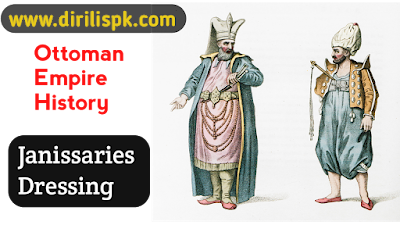What Was The Life Of a Ottoman Janissaries
The Janissaries were soldiers of elite infantry dedicated to protecting and guard the sultan of the empire ottoman and also the dependencies of the imperial palaces were par tof the first Ottoman army created in the middle ages,
educated and disciplined they formed a loyal troop that ended getting a lot of power and influence in political life and in the opinion of the sultan, were created by Orhan first who reigned from 1,326 to 1359 although its origins were slaves soon many families wanted their children were chosen to be part of this so prestigious military corps but also risky since it was a pride having a family member that it was Janissary.
History Of Ottoman Empire In English
At first it was not formed by Muslims but by prisoners of war Christians who abounded in the Ottoman prisons to which there were have to resort since no free man I would have wanted to be part of a infantry troop with so much risk to from 1,380 the sultan established a tax called Devshirme a kind blood tax that involved the recruitment of a child or youth Christian out of 40 households with ages that vary between 8 and 20 this form of recruitment possibly started in the 14th century and probably a every five years especially in the newly conquered balkans that still had a Christian majority, according to academic estimates a devshirme fully initiated could represent more than 1000 young people in a single year and covered only part of the quota of 8000 required by the state,
when did the ottoman empire end In English,
the idea behind this was that recruiters they were looking for healthy and strong children in addition to they could be easily molded indoctrinated in the religious, political field and military of the Ottoman state in constant rise.
History Of Ottoman Empire In English
 |
| Ottoman Empire History |
Janissaries Selection, Education & Training :
At first it was not formed by Muslims but by prisoners of war Christians who abounded in the Ottoman prisons to which there were have to resort since no free man I would have wanted to be part of a infantry troop with so much risk to from 1,380 the sultan established a tax called Devshirme a kind blood tax that involved the recruitment of a child or youth Christian out of 40 households with ages that vary between 8 and 20 this form of recruitment possibly started in the 14th century and probably a every five years especially in the newly conquered balkans that still had a Christian majority, according to academic estimates a devshirme fully initiated could represent more than 1000 young people in a single year and covered only part of the quota of 8000 required by the state,
when did the ottoman empire end In English,
the idea behind this was that recruiters they were looking for healthy and strong children in addition to they could be easily molded indoctrinated in the religious, political field and military of the Ottoman state in constant rise.
How the devshirme system was going evolving not all recruits juveniles were trained as Ottoman Janissaries some of them known for their apparent intelligence were selected as Ic Oglan or children of the internal service and they were sent to the palace schools after several tests that included proficiency tests and coefficient intellectual,
consequently they were offered the best education that the state had for offer in numerous fields such as administration, religion, army and the court etiquette were also trained in literature, horseback riding, archery, wrestling and even music, among they the brightest were evaluated and selected as members of the loyal staff of the sultan's palace a starting position from where they were destined for higher positions.
As for the other young people they were called Acemi Oglan foreign children and most of them were recruited in the Janissary body and although his education basic reflected that of the Ic Oglan the emphasis was more on obedience and military tactics in fact the most of the mentioned Acemi oglan they initially had to serve as Turk Oglan basically peasants who worked in the properties of the estimates
Turkish families during a period of seven years during this time not only they were used to work but who also had to practice his faith newly found Muslim after that the seven years were completed the youngsters were sent to the Acemi Ocak the training grounds for advanced military exercises and handling of arms curiously some of the Turk oglan candidates the ones showed their attitude in the tests were directly selected for Auxiliary divisions of
Janissaries uletters each consisting of 50 to 100 men from where they were often promoted to specialized bodies like the gunners and the gunsmiths some others they were also welcomed by households rich konaks of pashas and beys to be more educated and trained on the side provincial of elite affairs, and its military training was provided over a period of six years during this time the candidates were trained to use a variety of weapons including musket bows javelins and even fencing swords According to some sources, the Janissaries were extraordinary shooters that not only they could aim accurately but also maintain a speed of quick shot even in the light of the Moon.
Life Of a Ottoman Janissaries
The Janissaries were divided mainly in three groups the Cemaat largest or assembly that looked like front line troops and comprised 101 ortas the boluk that served as sultan's personal bodyguards and comprised 61 to 62 letters and finally the seymen that served as smaller guard to the commander general of the Ottoman Janissaries he offered the rank of whom Yeniceri Agassi-and the general was directly elected by the sultan and such was the power of this range that his orders couldn't even be questioned by the grand vizier for what they answered directly only to sultan,
Life Of a Ottoman Janissaries
 |
| Ottoman Empire History |
Division Of Janissaries & Discipline Guidelines :
The Janissaries were divided mainly in three groups the Cemaat largest or assembly that looked like front line troops and comprised 101 ortas the boluk that served as sultan's personal bodyguards and comprised 61 to 62 letters and finally the seymen that served as smaller guard to the commander general of the Ottoman Janissaries he offered the rank of whom Yeniceri Agassi-and the general was directly elected by the sultan and such was the power of this range that his orders couldn't even be questioned by the grand vizier for what they answered directly only to sultan,
like all elite corps were perfectly structured and organized and they had their own symbology curiously related to the gastronomy a career as jenizaro could have great advantages for promote socially for example a outstanding candidate immediately out of training could be assigned as the sultan's personal assistant after a few years in this position could branch out of the palace in an administrative function but even those who did not excel in the training from the start yet they could prove their worth and move up in the rows.
Given his penchant for discipline The Ottoman Janissaries were governed by their own military code and its ethics with 16 of the main guidelines formulated by sultan murat himself First some of these rules involved total obedience to the superior officer maintaining a behavior strict military promotion based on the seniority and applicable penalties only when they are given by their own officers any of the principles
They also alluded to the social aspect and that the Janissary recruits are not allows to keep the beard only they are allowed to live in the barracks I don't know allowed them to formally marry until retirement and they weren't allowed to play or consume alcoholic beverages and exceptionally they weren't allowed exhibiting extremes of wealth or abstinence.
Life Of a Ottoman Janissaries
As for punishments the most common was to be beaten on the soles of feet by sticks what is known as falaka after which the punished had than kiss the hand of your punisher symbolizing his return to the fold, they issued other serious punishments in the case of destruction of property and it offered adequate compensation to civilians.
Although not much is known about the armor adopted by the earliest Ottoman Janissaries from the 14th century you can suppose that given his main role as heavy infantry archers many of they wore chain mail underneath their colorful dolama coats, some of his assault brothers oriented melee possibly continued wearing special mesh vests and plates in addition to golden helmets with feathers until the 16th century in the late 16th century the various outfits of the Ottoman Janissaries were inspired by the persian fashion and as such its intricate dress codes often reflected military occasions formal in terms of uniforms common were made of wool but the most distinctive feature of the jenizaro uniform possibly meant to hats its typical bork hat that simulates
Life Of a Ottoman Janissaries
 |
| Ottoman Empire History |
Punishment :
As for punishments the most common was to be beaten on the soles of feet by sticks what is known as falaka after which the punished had than kiss the hand of your punisher symbolizing his return to the fold, they issued other serious punishments in the case of destruction of property and it offered adequate compensation to civilians.
 |
| Ottoman Empire History |
Clothing , Outfit, War Equipment , Food & Death Gratuity :
Although not much is known about the armor adopted by the earliest Ottoman Janissaries from the 14th century you can suppose that given his main role as heavy infantry archers many of they wore chain mail underneath their colorful dolama coats, some of his assault brothers oriented melee possibly continued wearing special mesh vests and plates in addition to golden helmets with feathers until the 16th century in the late 16th century the various outfits of the Ottoman Janissaries were inspired by the persian fashion and as such its intricate dress codes often reflected military occasions formal in terms of uniforms common were made of wool but the most distinctive feature of the jenizaro uniform possibly meant to hats its typical bork hat that simulates
a folded sleeve and I was garnished by a spoon afterwards they changed to flower pens and other objects since each of the members of an orta were the diners of his banner the kazan, the first Janissaries probably served as infantry archers heavy often called janissaries nefer the primary compound bow was accompanied by secondary weapons like short spears and swords the last mostly adopted by the 16th century included a variety of blades like the famous turkish kilic the yatagán double curved and wide gaddara, in the middle of the 15th century the arch soon was relegated to a ceremonial weapon and the janissary orts opted for weapons of fire meaning the match bus ark so both the associated characteristic weapon with the Ottoman Janissaries at their peak military belonged to the more version arcabus weighing with locks more longer and larger caliber the largest of these devastating pistols could shoot bullets up to 80 grams in weight.
Ottoman Empire Sultans In English,
Each of the nearly two hundred Ottoman Janizaros ortas worked like a military fraternity whose members were housed on their own barracks large establishments and well furnished with houses, kitchens and arsenal,however within these walls ostentatious jenizaros lived a style quite monastic life apart outside world but exercised indiscipline and obedience these troops highly disciplined and motivated could subsist on food singles that included only bread, meat,
dried fruits and porridge, at the same time the members of the orta they saw themselves as part of the brotherhood they take care of each other so much that even after the death of a fellow Janissary in battle was responsibility for the entire orta provide food rations and work for relatives more close to the deceased as for the payments the jenizaro regular received their payment around three to four times a year this is supplemented with bonuses that were offered to special units
however to despite the relatively high status of the Janissaries their starting salary no really reflected his elite position in the Ottoman army but with the time especially in the second half from the 15th century the sultans were more willing to increase the salary level and the Janizaros bonuses possibly due to the growing political influence of the body, in the early 16th century the janissaries add up to around 20,000 and that number would constantly increase but the Janissaries slowly lost power As a fighting force, the devshirme was abolished in 1638 and the prohibition of marriage also faded,
the sons of the janissaries were allowed in the ranks and soon the free citizens competed for join the late 17th century their number had increased to almost 80,000 in that moment the title almost made no sense and only about 10% could be called to defend the empire.





0 Comments